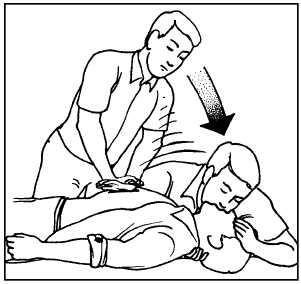1-8
Lean or rock forward with elbows locked, and apply vertical pressure to depress the sternum (adult)
1 1/2 to 2 inches. View B depicts this. Then release the pressure, keeping hands in place. Administer 60 to
80 compressions per minute.
You will feel less fatigue if you use the proper technique, and a more effective compression will
result.
Ineffective compression occurs when the elbows are not locked, the rescuer is not directly over the
sternum, or the hands are improperly placed on the sternum.
When one rescuer performs CPR, as shown in figure 1-4, the ratio of compressions to ventilations is
15 to 2. After 15 compressions, you must give the victim 2 ventilations. This ratio must continue for four
full cycles. Then check for pulse and breathing. If there are still no signs of recovery, continue CPR until
the victim can breathe unassisted or you are relieved by medical personnel.
Figure 1-4.—One rescuer CPR technique.
Before reviewing the next technique, let's go over the steps to take in an unwitnessed cardiac arrest
involving one rescuer.
1. Determine whether the victim is conscious.
2. Check the vital signs.
3. Ventilate four times (you may have to remove an airway obstruction at this time!).
4. Again check the vital signs; if none:
a. Begin compression-ventilation rate of 15 to 2 for four complete cycles.
b. Check pulse, breathing, and pupils. If no change
c. Continue compression-ventilation rate of 15 to 2 until victim is responsive or you are
relieved by medical personnel.



